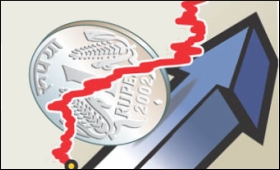|

|
Inflation worries
|
|

|
|
| Top Stories |
 |
|
|
|
Bikky Khosla | 23 Aug, 2016
Inflation is rearing its head again! Retail inflation rose to a two-year high of 6.07 percent in July, much above the RBI's target of 5 percent. Wholesale inflation also shot up to a 23-month high of 3.55 percent. These figures sound alarming at first glance, but experts view that there is no reason to panic -- the spike can be attributed partly to low base effect. Besides, inflation in July was mainly driven by high prices of food, which is a volatile item, impacted by weather and harvest. This year, we have good monsoon and are expecting record production of pulses. So, we should not read much into the latest figures.
The inflation data came on the heels of the Centre's announcement regarding its formal adoption of an inflation target of 4 percent (plus or minus two percent) for the RBI for next five years. Early this year, the government and the central bank had agreed to put in place a flexible inflation targeting monetary policy and now we have moved one step closer to a more disciplined monetary policy approach. An explicit target will help anchor industry's inflation expectations. Besides, the flexible range will help balance growth with inflation more efficiently. It is also to be noted that the new inflation target is in line with the one that is currently pursued by the central bank. Such policy continuity is must for macroeconomic stability.
In his Independence Day address, Prime Minister Modi gave his backing to the new inflation target, while attributing the spike in food prices to two consecutive droughts and expressing hope that a good monsoon would make things better this year. It sounds logical, but I think there is no scope for complacency. It is true that an above-average monsoon may play a role in curbing food inflation in the coming months, but such gains are likely to be only temporary and not long-term, and addressing the challenge instead requires extensive agricultural reforms. So, the Centre must take account of the reform needs of the sector.
Meanwhile, a top Commerce Ministry official last week said that exemptions and incentives for the export sector may be done away with once GST comes into effect, and so exporters will need to adapt to the the new environment. It's easier said than done. This sector has long been reeling under sluggish global demand, with 70 percent of the country's top export destinations facing economic slowdown, and now diluting the sops will only deteriorate the situation. Particularly, MSMEs in the sector will have to bear the brunt . I hope some remedial actions would be taken in this direction.
I invite your opinions.
|
|
|
| |
|
|
|
|
|
|
|
Export Exemptions
Rakesh Gupta | Wed Aug 24 04:44:01 2016
The Modi Govt.has been exceptionally financially prudent. I am hopeful that this trend will continue.Withdrawl of export incentives is a step in that direction and should be implemented, perhaps gradually.

Inflation
Flavio Faria-BR | Tue Aug 23 19:35:01 2016
The best way to control inflation is not talk in media this theme.

|
|
|
|
|
|
|
| |
| Customs Exchange Rates |
| Currency |
Import |
Export |
US Dollar
|
84.35
|
82.60 |
UK Pound
|
106.35
|
102.90 |
Euro
|
92.50
|
89.35 |
| Japanese
Yen |
55.05 |
53.40 |
| As on 12 Oct, 2024 |
|
|
| Daily Poll |
 |
 |
| Do you think Indian businesses will be negatively affected by Trump's America First Policy? |
|
|
|
|
|
| Commented Stories |
 |
|
|
|
|
|
| |
|